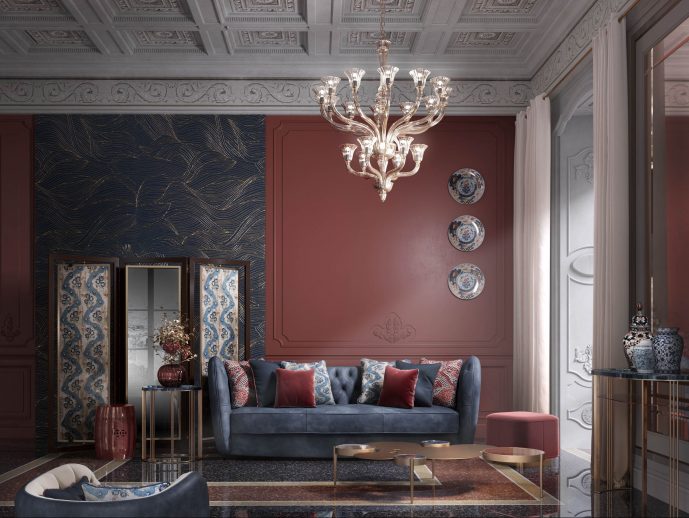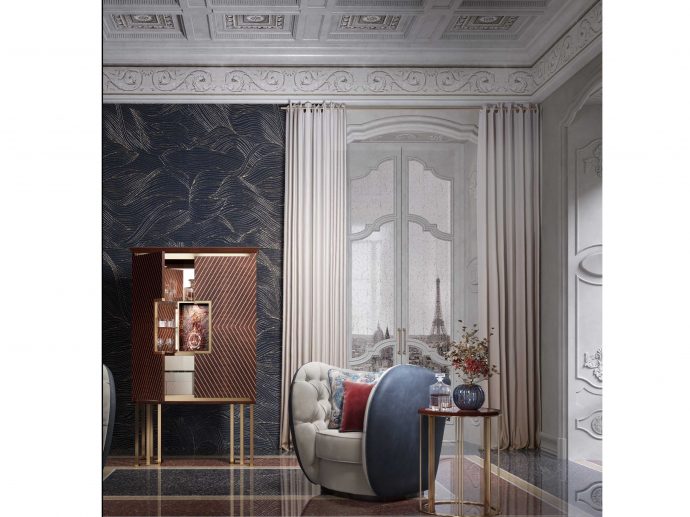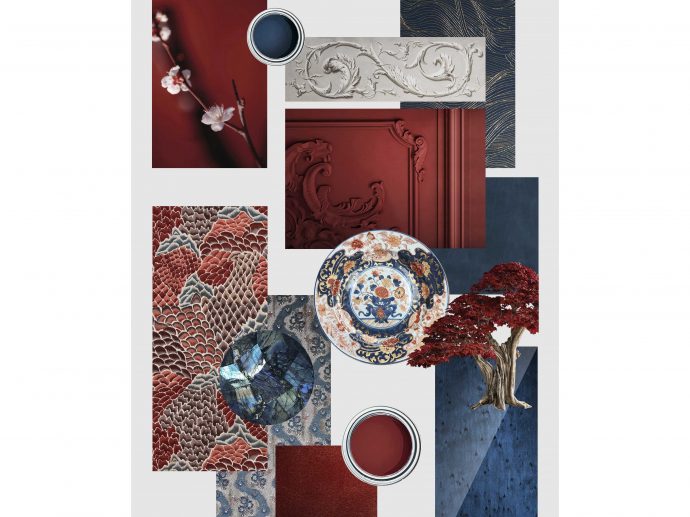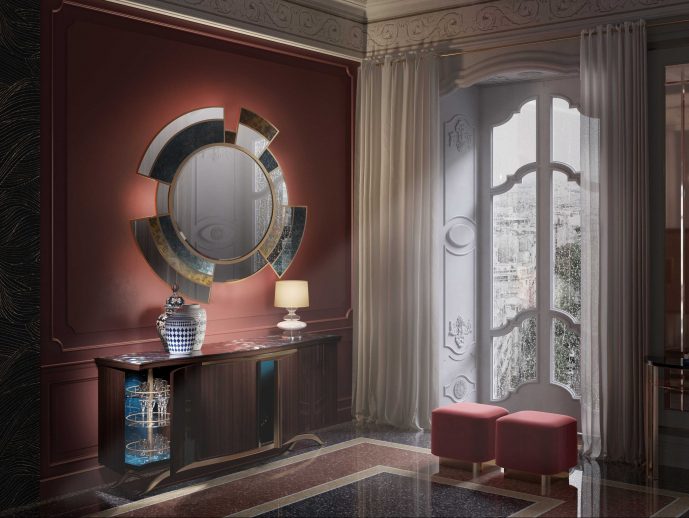Categories more
- Adventures (17)
- Arts / Collectables (15)
- Automotive (37)
- Aviation (11)
- Bath, Body, & Health (77)
- Children (6)
- Cigars / Spirits (32)
- Cuisine (16)
- Design/Architecture (22)
- Electronics (13)
- Entertainment (4)
- Event Planning (5)
- Fashion (46)
- Finance (9)
- Gifts / Misc (6)
- Home Decor (45)
- Jewelry (41)
- Pets (3)
- Philanthropy (1)
- Real Estate (16)
- Services (23)
- Sports / Golf (14)
- Vacation / Travel (60)
- Watches / Pens (15)
- Wines / Vines (24)
- Yachting / Boating (17)
Published
06/15/2020 by VITOLUPOEvery VITOLUPO piece of furniture collects the legacy of millennial cultures, excellent techniques and timeless styles. Precious materials such as Erable, Labradorite or Tiger Iron are used to embellish tables and consoles, sideboards and bar cabinets. Unique artifacts realised thanks to a very selected network of Italian artisans.
VITOLUPO chromatic choice for a contemporary, eclectic, nineteenth-century classic style, reaches the cobalt blue nuances of Oriental porcelain, the marsala red lustre of lacquers, the whiteness of sumptuous ivory velvets.
L’Eucalipto sofa in nabuk leather, with tulip-shaped body, offers a comfortable and cosy seat in the embrace of its high armrests. The capitonné padding, in contrast with the smooth and continuous line of the backrest, creates a fascinating material contrast between a soft inside and a rigid outside.
The evocative image that gave rise to Il Sambuco coffee table is that of lilies floating on the surface of the water. The brass concentric circles of the tabletop recall the ripples of a stone dropped in the water and imbue the surface with glimmering gold reflections. The surface relief suggests thick Impressionist brushstrokes. The Labradorite inlays heighten the fascination of the object and, through their iridescence, generate chromatic effects that call to mind Monet’s celebrated water lilies. The smoked glass invites the gaze beyond the surface, in search of sunken treasures.
The double movement of Il Lauro screen makes it functional and very flexible. The solid wood outer structure contains another lighter one, which can be rotated 360°. This rotating panels, free from direct contact with the floor, move in space and reflect the surrounding walls, modifying the aesthetics of the room. The rotating panels are made up of one mirrored side and the other covered by fabric or wood. Decorative meander motifs reminiscent of the sinuosity of the body of a dragon or a landscape of pines and mountains, pay tribute to the eastern screens in vogue in Europe in the XVII and XVIII century.
I Rododendri set of small tables and consoles develops from the brass bases with thin vertical strips. These metal structures support a wood tabletop with semi-precious stone inlays. It is a renaissance technique that reached excellence in the seventeenth century in Florence. This technique was used to decorate furniture and tabletops as it guarantees, through polychrome inlays, an effective contrast with the typical golden bases of tables and baroque consoles.
The main element of Il Mirto bar cabinet is the front niche, elegantly lined with brass foil, with the back panel in Tiger Iron semi-precious stone, reminds one of a tabernacle for storing an exquisite elixir. Opening the door panels, one is struck by an explosion of reflections and flashes of light that create an extraordinary scenic effect with surprise value.
Reminiscent of the ancient labyrinth, L’Alloro mirror refers to the poetics of ancient art. In the design, it is possible to recognize a stylized sun and the brass in the frame creates golden reflections. The round mirror is surrounded by cobalt and rainbow coloured inserts or by a comet finishing with silvery reflections.
The particular shape of La Quercia sideboard endows it with a motion that projects its lines beyond the horizon of the surface and becomes one with the surrounding room. The use of such noble materials as Rosewood, Blue Erable, bronze castings, and semi-precious stones contributes to a unique emotional experience, obtained through admirable plays of light. The Erable in the electric blue colour is enhanced thanks to the illumination of the two side "bar caskets". The cabinet doors, with their unusual corner opening, enhance the wonder. The entire body of the sideboard rests on a cast bronze base, that adds lightness. The long handles on the central doors endow the sideboard with an absolute indivisibility of language. Finally, the entire top surface is enhanced by the inlaid Labradorite. The primary characteristic of this splendid material is the optical phenomenon of Labradorescence, which appears as shimmering of various colours typical of many Eastern cultures, such as light blue, violet, green, yellow and orange.
The shape of L’Albicocco footstool recovers the values of soft, Oriental cushions, accentuating the idea of comfort and beauty. As if in a private and cosy Eastern sitting room, the assortment of several of these items, some brightly coloured, creates intimacy and striking chromatic effects.
The materials
Erable is a kind of maple characterised by bird’s eye figures highlighted by the leafing. This phenomenon has not yet been explained with certainty yet; however, it is thought that it could originate from the compression exerted by drops of water trapped in the delicate spring fibres, following sudden frosts. It is a wood of the highest aesthetic value, highly appreciated for its natural colour, but above all because it can be easily painted in various colours. In particular, the parts characterised by the presence of bird’s eye figures, are enhanced through the painting, thus acquiring an iridescent effect of depth.
Tiger iron is a semiprecious gem, known for its peculiar mineral composition. This stone presents an extraordinary phenomenon of “crawling", a beautiful effect of waving light due to the presence of bands of different minerals and different colours such as the red of the Jasper, the metallic grey of the hematite and the iridescent yellow of the tiger eye. These minerals merged over two billion years ago, literally embodying the growth and evolution of Mother Earth.
The main feature of Labradorite is the optical phenomenon of labradorescence. Under a light source, the stone magically transforms from a dull grey mineral, into a twinkle of flashes of bright blue, green, yellow and orange hues. It is an optical effect of iridescence that is manifested as a vivid colour that varies over the entire surface of the stone. The effect arises from the interference due to the presence of various laminar layers inside the mineral. An Eskimo legend tells that a wandering warrior, with spear shots, managed to free most of the lights of the Northern Lights imprisoned in the rock along the coast of Labrador; those that remained there formed the Labradorite.


















